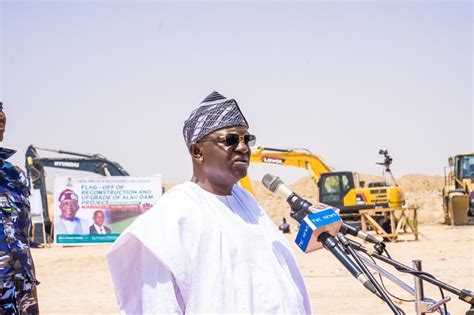425
By Tracy Moses
The Federal Government has refuted claims that the devastating flood which swept through Mokwa town in Niger State last Thursday was caused by water releases from the Kainji or Jebba dams, insisting that both hydro installations remain “intact and safe.”
Minister of Water Resources and Sanitation, Prof. Joseph Terlumun Utsev, made this known while addressing journalists at a press conference in Abuja on Tuesday.
“The flood in Mokwa was not due to water releases from Kainji or Jebba dams. Both dams are intact and safe,” Utsev stated unequivocally.
According to him, the disaster, which has so far claimed over 160 lives with more than 500 people still missing, was the result of “extreme weather conditions brought on by climate change,” further compounded by poor drainage, unregulated urban development, and the blockage of a key tributary of the River Dingi.
“This was a tragic confluence of natural and human factors,” he added.
Residents of Mokwa Local Government Area are still reeling from the aftermath of what locals describe as the worst flood in six decades, which submerged entire communities such as Tiffin Maza and Anguwan Hausawa, following a night of torrential rainfall.
The Minister explained that the downpour overwhelmed the area’s underdeveloped drainage systems and triggered an overflow in the dry-bed River Dingi, a regressive tributary of the River Niger that only flows during heavy rains.
“Unregulated buildings and construction activities blocked natural water pathways, preventing proper drainage. Without alternative water exit routes, the pressure built up and led to catastrophic flooding,” Utsev said.
Speaking exclusively with Pointblanknews.com, an engineer with the Nigeria Hydrological Services Agency (NIHSA), Mr. Hassan Mohammed, who is part of the technical team deployed to the area, confirmed the Minister’s stance.
“Our initial assessment aligns with the Ministry’s position. There’s no indication of dam-induced flooding. What we observed is a classic case of urban encroachment on floodplains and blocked water channels. Nature simply fought back,” he said.
Utsev noted that the Federal Government had foreseen and warned about the possibility of flooding through the 2025 Annual Flood Outlook (AFO) released on April 10, 2025, which flagged Mokwa among 19 LGAs in Niger State under high flood risk.
According to the AFO, 1,249 communities across 176 LGAs in 33 states, including Niger, fall within high-risk zones, while 2,187 communities in 293 LGAs are in moderate-risk areas.
The Minister used the opportunity to call on state governments, local authorities, and community leaders to take flood warnings more seriously.
“Strengthening drainage infrastructure, relocating people away from floodplains, enforcing land-use regulations, and improving public awareness campaigns are no longer optional, they are critical,” he stated.
Environmental advocate and convener of the Climate Resilience Nigeria initiative, Dr. Grace Egwu, told Pointblanknews.com after the event that the disaster should serve as a wake-up call.
“What happened in Mokwa is a climate change emergency worsened by human negligence. We must now invest in community-level resilience, not just paper plans. The Federal Government cannot do it alone,” she warned.
To ascertain the full extent and cause of the disaster, the Federal Ministry has deployed a team of experts from NIHSA, the Upper Niger River Basin Development Authority (UNRBDA), and the National Water Resources Institute (NWRI) to Mokwa.
“Their mandate is clear: conduct a thorough assessment and return with an evidence-based report to guide the government’s next steps,” Utsev said.
While offering condolences to the families affected by the disaster, Prof. Utsev reaffirmed the Federal Government’s commitment to supporting both the victims and the Niger State Government.
“Our hearts go out to the victims and their families. The Federal Government stands firmly with the people of Mokwa during this trying time,” he said.



